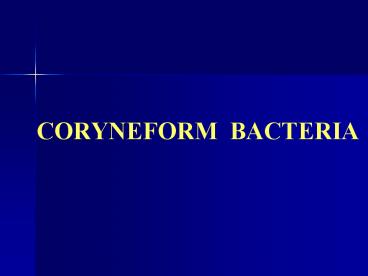CORYNEFORM BACTERIA PowerPoint PPT Presentation
1 / 24
Title: CORYNEFORM BACTERIA
1
CORYNEFORM BACTERIA
2
Diphteroids
- Pleomorphic gram-positive rods.
- Club Shaped (Chinese Letter like, V forms)
- Catalase ve
- Non sporing
- Non acid fast
3
Diphteroids (Continued)
- Commensals of the throat and skin of low
pathogenicity. - Morphologically similar to the pathogenic
C.diphtheriae. - Can be found as contaminants of blood cultures
and CSF. - Can cause opportunestic infections in
Immunosupressed patients.
4
Corynebacterium diphtheriae (diphtheria)
- Local infection of the throat with grayish
adherent exudate (Pseudomembrane) and generalized
toxaemia due to production and dissemination of a
highly potent toxin.
5
Etiology Corynebacterium diphtheriae
- 3 Types of Colony
- Mitis (Mild disease)
- Intermedius (Intermediate dis.)
- Gravis (severe)
- Strains may be toxegenic or non-toxegenic.
- Production of toxin is mediated by bacteriophage
(ß phage) infection of the bacterium.
6
Etiology Corynebacterium diphtheriae (Continued)
- The demonstration of toxin production is
essential to differentiate toxegenic from
commensal corynebacteria. - Toxogenicity is demonstrated by the agar gel
precipitation (Elek) test or by the polymerase
chain reaction (PCR).
7
Clinical Manifestation
- Usually gradual onset of local infection.
- Membranous nasopharyngitis
- Obstructive laryngotrachitis
- With low grade fever
- Malaise
- Fatigue
- Sore throat
8
Grey tonsillar membrane in acute diphtheria
9
Clinical Manifestation (Continued)
- Clinically
- Nasal diph. thick nasal discharge
(intoxication rare) - Pharyngial thick, adherent pseudomembrane
- (intoxication common)
- (tonsillar) Odema, Heat Tenderness of tissue
of neck (Bull neck) - Laryngial extension of membrane
- (asphyxia)
10
Clinical Manifestation (Continued)
- Less Commonly
- Cutanous
- Vaginal
- Conjunctival or otic
11
Clinical Manifestation (Continued)
- Life threating complication include
- Upper airway obstruction (extension of membrane)
- Myocarditis (heart failure)
- Neurologic Peripheral neuritis
- Vocal cord paralysis
- Ascending paralysis
- Difficulty in swallowing
- Visual disturbance
12
Epidemiology
- Humans are the only reservoir.
- Sources of Infections
- Discharges from nose, throat, eye and skin
lesions of infected patients or carriers (direct
contact) - Most common in low socioeconomic groups in
crowded conditions. - Since 1990 epidemics in Soviet Union, Russia
with 50,000 cases 1750 deaths.
13
Epidemiology (Continued)
- Case fatality 3 - 23
- Children are susceptable after 3-6 months
(highest incidence). - Latent skin infection immunity.
- Communicability 2 weeks (untreated
person) - lt4 days (treated patients)
- Incubation Period is 2- 5 days.
14
Pathogenesis
- Powerful exotoxin ( blood stream)
- Toxin local and systemic toxicity
- (toxin mediated disease)
- Cause of mortality in clinical diphtheria.
- Affinity for heart muscles, nerve endings and
adreral glands. - Produced by ß phage infected C.diphtheriae.
15
Pathogenesis (Continued)
- Rapidly diffused from local lesion irreversibly
bound to tissues. - ADP ribosylating toxin protein synthesis
inhibition cell death necrosis and
neutroxic effects. - Bacilli (local effect), no deep penetration to
blood or underlying tissue. - Inflammatory exudate and necrosis of pharyngeal
muscles respiratory obstruction.
16
Diagnosis
- Clinical diagnosis
- Lab should not delay management.
- Specimen for culture
- Nose From both
- Throat Patient and carrier
- Lesions
17
Elek plate demonstrating toxin from
Corynebacterium diphtheriae
18
Diagnosis (Continued)
- Direct stained smear unreliable (Commensals)
- Special media (Potassium -tellurite) and enriched
Loefflers slope (selective) grey black
colonies. - Albert stain metachromatic granules.
- Toxogenicity test (Elek test, PCR) is most
important, guinea pig inoculation. - Elek test agar gel precipitation.
19
Management
- Patient
- Fatality with delay (0 -20)
- 1- Antitoxin
- Equine antitoxin neutralize the toxin
- Start soon if clinically suspected.
- 2- Isolation of the patient (droplet
precautions) - 3- Antibiotics (no effect on toxin)
- to eradicate organism and prevent spread
- (a) Penicillin oral
- (b) Erythromycin
20
Management (Continued)
- 3- Contacts (Close)
- Investigated for signs of disease
- Carriage (nose, throat)
- Chemoprophylaxis (erythromycin)
- Immunization of susceptiable contacts (diph.
toxoid) - Carriers isolated and treated.
21
Prevention and Control
- Universal immunization with diph. toxoid the only
effective control measure. - High immunization rate among children (3 doses of
DPT 2 boosters at 2 month age) - Regular booster (Td every 10 years).
- Vaccine formalin treated toxin highly
antigenic, not toxic.
22
Listeria monocytogenes
- Listeria monocytogenes is widespread in nature
and has been - isolated from the stools of 5 healthy adults. A
variety of foods are contaminated with LM. It has
been recovered from raw - vegetables, raw milk, fish, poultry, soft
cheese and meats at - rates ranging from 15 to 70
23
- Resistance to LM infection is predominantly
cell-mediated - Evidence of this is provided by the
overwhelming clinical - association between Listeria infections and
conditions associated with impaired cellular
immunity, including lymphomas, pregnancy, AIDS
and corticosteroid-induced immunosupression - in transplant recipients.
24
- Listeria monocytogenes (LM) meningitis is rare in
patients with a normal immune status. Most
reported cases have been associated with
immunosupression produced by drugs (steroids and - cytotoxic drugs), chronic renal disease,
diabetes, malignancy - and HIV . Additional groups include neonates ,
pregnant - women and elderly

